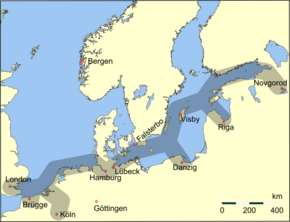Osnabrück
| Osnabrück | |
| Coat of arms | Location |
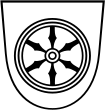 |
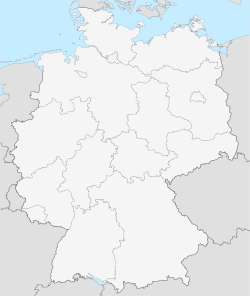 |
| Administration | |
| Country | Germany |
|---|---|
| State | Lower Saxony |
| District | Urban district |
| Lord Mayor | Boris Pistorius (SPD) |
| Basic statistics | |
| Area | 119.80 km² (46.3 sq mi) |
| Elevation | 63 m (207 ft) |
| Population | 163,357 (29/06/2006) |
| - Density | 1,364 /km² (3,532 /sq mi) |
| Other information | |
| Time zone | CET/CEST (UTC+1/+2) |
| Licence plate | OS |
| Postal codes | 49074–49090 |
| Area code | 0541 |
| Website | www.osnabrueck.de |
Osnabrück (IPA: [ɔsnaˈbʁʏk]) is a city in Lower Saxony, Germany, some 80 km NNE of Dortmund, 45 km NE of Münster, and some 100 km due west of Hannover. It lies in a valley penned between the Wiehengebirge and the northern tip of the Teutoburg Forest. As of June 30, 2006, its population was 163,357, making it the third largest city in Lower Saxony.
Contents |
History
Osnabrück developed as a marketplace next to the bishop's see founded by Charlemagne, king of the Franks, 780. Some time before 803, the city became seat of the Prince-Bishopric of Osnabrück. Also uncertain, but it makes Osnabrück the oldest bishopric in Lower Saxony. In the year 804 Charlemagne possibly founded the Gymnasium Carolinum (a school), which would make it the oldest German Gymnasium. But the charter with the date is disputed and could be a forgery.
In 889 it was given merchant, customs, and coinage privileges by King Arnulf of Carinthia. It is first mentioned as a "city" in records in 1147. Shortly afterwards, in 1157, Emperor Frederick Barbarossa granted the city fortification privileges (Befestigungsrecht). Most of the towers that were part of the medieval fortification are still visible in the city. Osnabrück became a member of the Hanseatic League in the 12th century, as well as a member of the Westphalian Federation of Cities.
The main period of witch hunting in Osnabrück was between 1561 and 1639. In the year 1582 during the reign of major Hammacher (1565-1588) 163 women were killed as alleged witches, most of them burned. During the tenure of major Dr. Pelster between 1636-1639, more than 40 women were killed as witches. In total, 276 women and 2 men were executed after a witch trial for wizardry.
In 1632 a Jesuit university was founded emanating from the Gymnasium Carlinum. One year later it was closed by the Swedish reign of the Prince-Bishop. Between 1643-1648 negotiations in Münster and Osnabrück led to the Peace of Westphalia.
The city passed to the Electorate of Hanover in 1803 during the German Mediatisation and then briefly to the Kingdom of Prussia in 1806. It was part of the Kingdom of Westphalia from 1807-10, after which it passed to the First French Empire. After the Napoleonic Wars, it became part of the Kingdom of Hanover in 1815. Osnabrück was then annexed by Prussia in 1866 after the Austro-Prussian War and administered within the Province of Hanover. The city became part of the new state of Lower Saxony in 1946 after World War II.
Main sights
- Town Hall. It houses the Friedensaal, where the Peace of Westphalia was signed.
- St. Peter's Cathedral, founded in the 11th century. It has two façade towers, originally of the same size: in 1502-1543 the south western tower was enlarged, supposedly to make space for new cathedral bells which had been ordered and that turned out to be too large
- Heger Tor ("Heger Gate"), a monument to the soldiers from Osnabrück who died at the battle of Waterloo (1815).
- Bucksturm, the oldest tower in the city, and once part of the city walls. It was once used as prison for women accused of witchcraft.
- Ruwe Fountain" (1985), created for the city's 1200th birthday.
- Gladiator 2000 (1986), a gigantic painture (45 × 6 meters) by Nicolae Covaci.
- Felix Nussbaum Haus A Gallery and Museum dedicated to the Jewish artist and Painter Felix Nussbaum who died in the Holocaust
- Kalkriese Museum, situated on the battlefield of the Teutoberger Wald, in which German tribes under Arminius destroyed three Roman legions. It exhibits artefacts unearthed on the battlefield and tells the story of how the battle came to be.
Famous people
Personalities from Osnabrück include the writer Erich Maria Remarque and the painter Felix Nussbaum, for whom the city erected a very modern museum designed by Daniel Libeskind that opened in 1998. This looks like a scaled-down version of the same architect's well-known Jewish Museum in Berlin. British King George I was born and raised here, and the poet and scholar Johann Ernst Hanxleden was born in Osnabrück, as was the current Prime Minister of Lower Saxony, Christian Wulff,and reggae musician Gentleman. Victory Records recording artists Waterdown, known for their catchy post-hardcore sound, are based in Osnabrück. Actress Birgitta Tolksdorf, who made a name for herself in American television in the 1970s, as well as Peter van Pels, love interest of famous diarist Anne Frank, and his parents Auguste van Pels and Hermann van Pels, who would later gain fame from their roles in Anne's diary, all hailed from Osnabruck. The famous German stage and screen actor Mathias Wieman (1958 recipient of the Justus-Möser-Medaille) was born and raised in the city. The city is also hometown of well-known European politician and current European Parliament President Hans-Gert Pöttering.
Education
Two universities, the Universität Osnabrück (University of Osnabrück) and the Fachhochschule Osnabrück (University of Applied Science of Osnabrück), are located in the city. There also are all kinds of German grammar schools, including seven Gymnasien. As mentioned above, one of them, The Carolinum, may be the oldest school in Germany, which does still exist today.
Transportation
The city of Osnabrück is connected by road to the A1, the A30 and the A33. It shares the Münster Osnabrück International Airport together with the nearby city of Münster.
The "Hauptbahnhof" (Main Station) of Osnabrück is an important railway station. Travellers from the Netherlands heading for either Hamburg and Denmark, or Berlin and Eastern Europe, often have to change here.
An extensive bus service operated by Stadtwerke Osnabrück provides transportation within Osnabrück and the surrounding region.[1] The primary bus center is located at the Neumarkt shopping area, a short distance from the train station.
Districts of Osnabrück
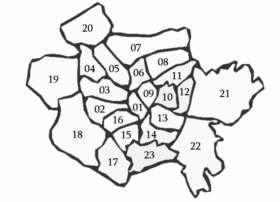
The city is divided into 23 districts:
|
|
|
Name
The origin of the name Osnabrück is disputed. The suffix -brück suggests a bridge over or to something (from German Brücke = bridge) but the prefix Osna- is explained in at least two different ways: the traditional explanation is that today's name is a corruption of Ochsenbrücke (meaning "ox' bridge") but others say that it is derived from the name of the Hase River which again is argued to be derived from Asen (Æsir), giving Osnabrück the meaning Bridge to the Gods.[1] The pronunciation of the city's name can also serve as a means of telling if one is a native of Osnabrück or a visitor: most people from Osnabrück stress the last syllable while most people from elsewhere stress the first one. The city gave name to the textile fabric of Osnaburg (remember: "-burg" means castle and in names, town).
Notable residents
- Erich Maria Remarque, famous writer
- Gentleman (musician), a successful Reggae musician
- Heinrich Abeken, German theologian and Prussian Privy Legation Councillor in the Ministry of Foreign Affairs in Berlin
- Felix Nussbaum, known mostly for his surrealist paintings
- Christian Wulff, Minister-President of Lower Saxony
- Hans Gert Pöttering, President of the European Parliament
- Mathias Wieman, famous actor.
Twin cities
 Haarlem, Netherlands, since 1961
Haarlem, Netherlands, since 1961 Angers, France, since 1964
Angers, France, since 1964 Gmünd, Austria, since 1971 (friendship link)
Gmünd, Austria, since 1971 (friendship link)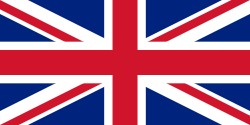 Derby, United Kingdom, since 1976
Derby, United Kingdom, since 1976 Greifswald, Germany, since 1988
Greifswald, Germany, since 1988 Tver, Russian Federation, since 1991
Tver, Russian Federation, since 1991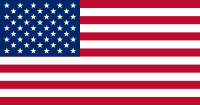 Evansville, United States, since 1991 (friendship link)
Evansville, United States, since 1991 (friendship link) Kwangmyong, Korea, since 1997 (friendship link)
Kwangmyong, Korea, since 1997 (friendship link) Çanakkale, Turkey, since 2004
Çanakkale, Turkey, since 2004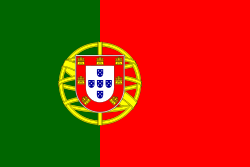 Vila Real, Portugal, since 2005
Vila Real, Portugal, since 2005 Hefei, China, since 2006 (friendship link)
Hefei, China, since 2006 (friendship link) Afula, Israel
Afula, Israel
Twinning with Derby
Osnabrück is twinned with Derby in England. The partnership treaty between the two cities was signed on 17 February 1976.
Osnabrück made contact with the British authorities as early as 1948, hoping to find an English twin town and therefore come to understand their former enemies from the Second World War. Unfortunately this attempt was unsuccessful and Osnabrück did not consider an English twin town again until 1972. The twinning agreement with Derby was signed four years later in the historical Hall of Peace in Osnabrück's town hall. Since then the two towns have exchanged envoys.
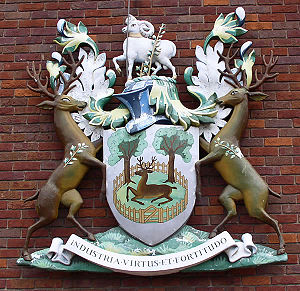
Osnabrück now has eleven twin and friendship cities: Derby (England), Anger (France), Haarlem (Netherlands), Çanakkale (Turkey), Tver (Russia), Greifswald (Germany), Vila Real (Portugal), Hefei (China), Evansville (USA), Gmünd (Austria), Kwangmyong (South-Korea) and there are five envoys working at the twinning office in Osnabrück, who represent Derby, Angers, Haarlem, Tver and Çanakkale.
Every year, Derby and Osnabrück each appoint an Envoy who spends twelve months in his or her twin city. The Envoy's role is varied, but encompasses areas such as promoting the exchange of ideas between the two cities, as well as acting as an educational and general information officer to promote awareness of the twinning scheme. They can help in all sorts of ways by: translating, giving talks to local societies and schools, finding pen friends and short term host families during work placements, working in day-to-day contact to assist groups who want to get involved in twinning by identifying and approaching possible counterparts, planning the annual mayweek trip and a lot more.
The exchange of Envoys between two cities is very unusual. The team of Envoys in Osnabrück changes every year and Osnabrück also sends envoys to Derby, Angers and Çanakkale. No other city in Germany participates in this exchange of Envoys, and in Britain, only one other city, Wigan, receives and sends an Envoy.
The twinning gives the inhabitants of both places the opportunity to interact with their international neighbours. Town twinning intends to enhance international understanding and break down social barriers.
External links
- Osnabrueck.de Official website (German)
- City Panoramas
- Photo of the historic Town Hall
- Remarque centre (English) (German)
- University of Osnabrück (German) (German)
- Twinning link with Derby (English)
References
- Gerd Steinwascher (editor): Geschichte der Stadt Osnabrück Meinders & Elstermann, Belm 2006, ISBN 3-8892-6007-1
|
||||||||||||||||||||||||||
|
|||||||||||

